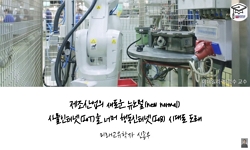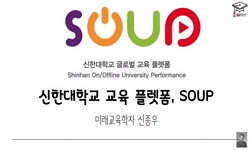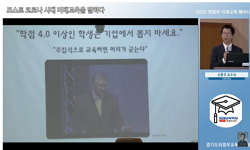(Background and Purpose) New normal is a term that refers to a new standard that contrasts with existing values, and the main factors of it include the Fourth Industrial Revolution, demographic change, low growth, and climate change. Accordingly, a co...
http://chineseinput.net/에서 pinyin(병음)방식으로 중국어를 변환할 수 있습니다.
변환된 중국어를 복사하여 사용하시면 됩니다.
- 中文 을 입력하시려면 zhongwen을 입력하시고 space를누르시면됩니다.
- 北京 을 입력하시려면 beijing을 입력하시고 space를 누르시면 됩니다.

뉴노멀시대 도시공원 계획특성에 관한 연구 = A Study on the Characteristics of Urban Park Planning in the New Normal Era
한글로보기https://www.riss.kr/link?id=A107402756
- 저자
- 발행기관
- 학술지명
- 권호사항
-
발행연도
2021
-
작성언어
-
-
주제어
New Normal ; Change of the times ; Response ; Urban Parks ; Planning characteristics ; 뉴노멀 ; 시대변화 ; 대응성 ; 도시공원 ; 계획특성
-
KDC
600
-
등재정보
KCI등재
-
자료형태
학술저널
- 발행기관 URL
-
수록면
353-364(12쪽)
-
KCI 피인용횟수
1
- DOI식별코드
- 제공처
-
0
상세조회 -
0
다운로드
부가정보
다국어 초록 (Multilingual Abstract)
(Background and Purpose) New normal is a term that refers to a new standard that contrasts with existing values, and the main factors of it include the Fourth Industrial Revolution, demographic change, low growth, and climate change. Accordingly, a comprehensive and flexible response to social changes and problems is required. The importance of urban parks is emerging as they can be used in various and complex ways depending on the lifestyle. Therefore, this study aims to cope with the ongoing changes by studying the characteristics of urban parks to reflect the new public values of the New Normal Era. (Method) First, in this study, four main factors that lead the New Normal Era were extracted from the literature and the Internet, and the relationship was identified by in-depth analysis to derive the characteristics of the New Normal Era and countermeasures. Next, the change in urban space due to the change of times was theoretically considered for the function of the park and the planning characteristics (plan) were derived by analyzing whether the change in urban space could meet the existing park functions. An expert survey analysis was conducted to verify the suitability of the planning characteristics and their association with the New Normal Era response direction and to materialize them into an analysis model. (Results) Two recently created neighborhood parks were analyzed to verify the effectiveness of the analysis model. As a result, both parks had sufficient land, planned construction, and management systems, resulting in high overall measurements of the park's planning characteristics in the New Normal Era. Both parks lacked high-tech and flexibility among their mutual supportability. Urban linear parks lacked disaster prevention and vegetation, resulting in low levels of health, responsiveness, and environmental characteristics related to resilience, while urban outer parks had low accessibility and locality related to urban inclusion. There were differences depending on the terrain and location of the park. (Conclusions) Urban parks shall be created as spaces to accommodate the changed values of the New Normal Era. Based on the overall factors of time change, the study presented the planning characteristics of urban parks, which derived the direction of urban parks in the New Normal era in terms of mutual support, resilience, and urban inclusion. The analysis model presented in this study can be used as a basic data useful for park maintenance design as it can identify the acceptance and complement of existing parks in advance. The analysis model presented in this study can be used as a basic data useful for park maintenance design as it can identify the acceptance and complement of existing parks in advance.
참고문헌 (Reference)
1 변미리, "포용도시를 향하여_서울형 포용도시지표개발과 포용성 진단" 서울연구원 1-26, 2018
2 한영준, "탄력적도시회복을 위한 인프라 구축방안" 서울연구원 49-68, 2020
3 이종찬, "코로나와 4차산업혁명이 만든 뉴노멀" 북랩 2020
4 이재완, "코로나 뉴노멀 시대, 지역사회복지의 변화와방향" 3-28, 2020
5 송강직, "제4차 산업형명이 노동법제에 미치는 영향- 일본에서의 논의를 중심으로-" 중앙법학회 20 (20): 274-310, 2018
6 이희연, "제4주제저출산 고령화 저성장 시대의 도시환경 여건변화" 57 : 81-85, 2016
7 김대익, "정보화시대 도시주거의 장소성에 관한 시론" 한국도시설계학회 11 (11): 5-20, 2003
8 김동은, "전세계 자연재해 추이" 41 (41): 56-61, 2008
9 민성희, "저성장시대의 합리적인 도시지역계획 수립방안" 1-6, 2019
10 양재섭, "저성장시대 서울의 도시정책을 말하다" 서울연구원 2016
1 변미리, "포용도시를 향하여_서울형 포용도시지표개발과 포용성 진단" 서울연구원 1-26, 2018
2 한영준, "탄력적도시회복을 위한 인프라 구축방안" 서울연구원 49-68, 2020
3 이종찬, "코로나와 4차산업혁명이 만든 뉴노멀" 북랩 2020
4 이재완, "코로나 뉴노멀 시대, 지역사회복지의 변화와방향" 3-28, 2020
5 송강직, "제4차 산업형명이 노동법제에 미치는 영향- 일본에서의 논의를 중심으로-" 중앙법학회 20 (20): 274-310, 2018
6 이희연, "제4주제저출산 고령화 저성장 시대의 도시환경 여건변화" 57 : 81-85, 2016
7 김대익, "정보화시대 도시주거의 장소성에 관한 시론" 한국도시설계학회 11 (11): 5-20, 2003
8 김동은, "전세계 자연재해 추이" 41 (41): 56-61, 2008
9 민성희, "저성장시대의 합리적인 도시지역계획 수립방안" 1-6, 2019
10 양재섭, "저성장시대 서울의 도시정책을 말하다" 서울연구원 2016
11 서동진, "장소 정체성을 위한 도시 공공공간 유형 연구" 한국공간디자인학회 11 (11): 89-99, 2016
12 원광희, "인구감소 및 고령화시대 도시계획의 과제와 전략" 충북연구원 2019
13 성현찬, "이용자 중심의 도시공원 조성 방안" 경기연구원 2009
14 김원주, "시민 건강증진 위한 도시공원 활용도의 향상방안" 서울연구원 2017
15 서지영, "미래위험과 회복력" 과학기술정책연구원 2014
16 최희선, "도시의 지속가능성을 위한 공원녹지 정책의 재정립방안" 한국환경정책 평가연구원 2019
17 김동현, "도시의 새로운패러다임 가능성 – 리질리언스" 12 : 3-26, 2015
18 김효경, "도시공원 내 오픈스페이스 이용자 행태 분석 - 서울 숲을 중심으로 -" 대한건축학회 26 (26): 37-44, 2010
19 유철하, "도시 어메니티 향상을 위한 가로시설물 디자인 개선 방향에 관한 연구 -신도시 공원을 중심으로-" 한국디자인문화학회 15 (15): 333-343, 2009
20 정현, "뉴노멀 시대의 국내 패션산업 메가트렌드 연구" 한국기초조형학회 19 (19): 391-404, 2018
21 임휘룡, "공공복지를 고려한 생태계서비스로서의 공원녹지 정책에 관한 연구 : 서울시 성북구를 사례로" 상명대학교 대학원 2014
22 Lee, Sunghee, "Urban Planning Strategy and Technique for Climate Change Adaptation" 6 (6): 153-174, 2015
23 Kim, shinhwa, "Study on the Sustainability Evaluation Index of Urban Neighbourhood Parks" Dankook University 2019
24 Park, Taewook, "Study of Characteristics of Visual Cognition for the Formative Elements in the Public Environment" Kyunghee University 2012
25 Yang, Gwangmo, "A Study on Smart Park Planning Indicator" Sangmyung University 2021
26 Song, Inju, "A Study on Creation of Eco-welfare City through Park and Green space" The Seoul Institute 2012
27 미래창조과학부 미래준비위원회, "10년 후 대한민국 뉴노멀 시대의 성장전략" 시간여행 2016
동일학술지(권/호) 다른 논문
-
니콜라 부리오의 확장된 관계미학적 관점으로 본 현대전시 공간특성
- 한국공간디자인학회
- 김햇빛 ( Kim Haetbit )
- 2021
- KCI등재
-
평면 스케치 딥러닝 학습모델 구축과 공간디자인 활용 - 평면 스케치 인식 기반 설계초기 BIM 모델 자동생성 모듈 개발 중심으로 -
- 한국공간디자인학회
- 조단규 ( Cho Dahngyu )
- 2021
- KCI등재
-
코로나 19 대응형 농촌관광 유형 특성 및 콘텐츠 개발 연구
- 한국공간디자인학회
- 최찬원 ( Choi Chanwon )
- 2021
- KCI등재
-
친환경건축인증 공공건축물의 지속가능성 개념에 따른 표현 특성 연구 -국내 친환경건축인증 공공청사를 대상으로-
- 한국공간디자인학회
- 정은희 ( Jung Eunhee )
- 2021
- KCI등재
분석정보
인용정보 인용지수 설명보기
학술지 이력
| 연월일 | 이력구분 | 이력상세 | 등재구분 |
|---|---|---|---|
| 2022 | 평가예정 | 재인증평가 신청대상 (재인증) | |
| 2019-01-01 | 평가 | 등재학술지 유지 (계속평가) |  |
| 2016-01-01 | 평가 | 등재학술지 선정 (계속평가) |  |
| 2015-06-01 | 학술지명변경 | 외국어명 : Journal of the Korea Intitute of the spatial design -> Journal of Korea Intitute of Spatial Design |  |
| 2015-01-01 | 평가 | 등재후보학술지 유지 (계속평가) |  |
| 2013-01-01 | 평가 | 등재후보 1차 FAIL (등재후보1차) |  |
| 2012-01-01 | 평가 | 등재후보학술지 유지 (기타) |  |
| 2011-01-01 | 평가 | 등재후보 1차 PASS (등재후보1차) |  |
| 2009-01-01 | 평가 | 등재후보학술지 선정 (신규평가) |  |
학술지 인용정보
| 기준연도 | WOS-KCI 통합IF(2년) | KCIF(2년) | KCIF(3년) |
|---|---|---|---|
| 2016 | 0.47 | 0.47 | 0.53 |
| KCIF(4년) | KCIF(5년) | 중심성지수(3년) | 즉시성지수 |
| 0.51 | 0.52 | 0.692 | 0.28 |





 KCI
KCI KISS
KISS






